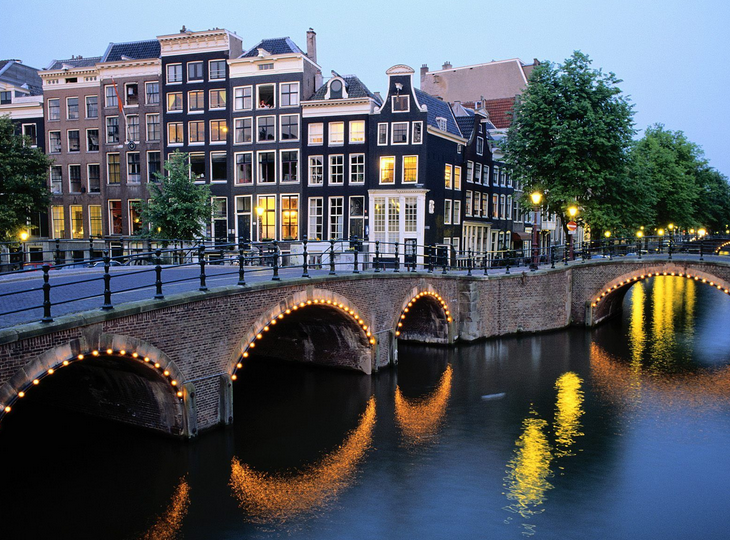HOLLAND
When we think about Holland we of course associate this with the old traditional stories about boys with fingers in the dam etc. But when we visited what I personally found most unusual was driving along the motorway and seeing a bridge ahead with a boat crossing above your head. This for me was surreal. Then the windmills jump into your imagination, the cheese, the bicycles, the thousands of miles of dams and waterways. Tulips in Amsterdam is another great Dutch asset.
The Netherlands, on the coast of the North Sea, is twice the size of New Jersey. Part of the great plain of north and west Europe, the Netherlands has maximum dimensions of 190 by 160 mi (360 by 257 km) and is low and flat except in Limburg in the southeast, where some hills rise up to 322 m (1056 ft). About half the country’s area is below sea level, making the famous Dutch dikes a requisite for efficient land use. Reclamation of land from the sea through dikes has continued through recent times. All drainage reaches the North Sea, and the principal rivers—Rhine, Maas (Meuse), and Schelde—have their sources outside the country.
History
Julius Caesar found the low-lying Netherlands inhabited by Germanic tribes—the Nervii, Frisii, and Batavi. The Batavi on the Roman frontier did not submit to Rome’s rule until 13 B.C. , and then only as allies.
The Franks controlled the region from the 4th to the 8th century, and it became part of Charlemagne’s empire in the 8th and 9th centuries. The area later passed into the hands of Burgundy and the Austrian Hapsburgs and finally, in the 16th century, came under Spanish rule.
When Philip II of Spain suppressed political liberties and the growing Protestant movement in the Netherlands, a revolt led by William of Orange broke out in 1568. Under the Union of Utrecht (1579), the seven northern provinces became the United Provinces of the Netherlands. War between the United Provinces and Spain continued into the 17th century but in 1648 Spain finally recognized Dutch independence.
The Dutch East India Company was established in 1602, and by the end of the 17th century, Holland was one of the great sea and colonial powers of Europe.
The nation’s independence was not completely established until after the Thirty Years’ War (1618–1648), when the country’s rise as a commercial and maritime power began. In 1688, the English Parliament invited William of Orange, stadtholder, and his wife, Mary Stuart, to rule England as William III and Mary II. William then used the combined resources of England and the Netherlands to wage war on Louis XIV’s France. In 1814, all the provinces of Holland and Belgium were merged into one kingdom, but in 1830 the southern provinces broke away to form the kingdom of Belgium. A liberal constitution was adopted by the Netherlands in 1848. The country remained neutral during World War I.
Read more: Netherlands: Maps, History, Geography, Government, Culture, Facts, Guide & Travel/Holidays/Cities | Infoplease.com http://www.infoplease.com/country/netherlands.html#ixzz2akHUzxzE
Amsterdam of course is her Capital City, famed not only for its beauty but of its erotic night life. Amsterdam is the capital and most populous city of the Netherlands. Its status as the Dutch capital is mandated by the Constitution of the Netherlands, although Amsterdam is not the seat of the Dutch government which is The Hague.
The ‘Begijnhof’ is one of the most beautiful places in Amsterdam. It’s an inner court that dates from around 1300 with typical Amsterdam-style houses. The Begijnhof has a fascinating history with many historical events, the sisterhood of Catholics and even miracles.
Some trivia on the Dutch and Holland
The Dutch are the world experts on keeping the water back from where it came and from the sea and rivers turning Netherlands into an Atlantis. The US government turned to the Dutch for help during the hurricane Katrina disaster. The Dutch are the tallest in the world with on average the height of 184 cms. for men and 170 cm for women. The highest point in Netherlands, Vaalserberg, is only 323 meters above sea level. The rest of the nation is as flat as a pancake.
Some believe its the combined result of DNA and dairy. They also make the most bacon in europe. The Schiphol Airport is actually 4.5 m below sea level.
Most graves are leased for 10, 15 or 20 years only and not purchased due to the short supply of grave space. The famous Dutch windmills were used to pump away water for hundreds of years. The Dutch have been making cheese since 400 AD. and if course it is the largest exporter of cheese in the world with a dairy industry turning over around EUR7 billion. Cheese markets where farmers’ cheeses have been weighed,tasted and priced for the past 300 years still exist in Woerden and Gouda. Dutch cheese is officially the best cheese in the world,as agreed by 40 judges from 17 countries who judged 2,500 cheeses in the 2012 World Cheese Making Contest held in the US.
ROTTERDAM, The Netherlands, birthplace of Carel Van Druten. Carel married Elizabeth Quilietti and this is our link to that country

Leave a Reply